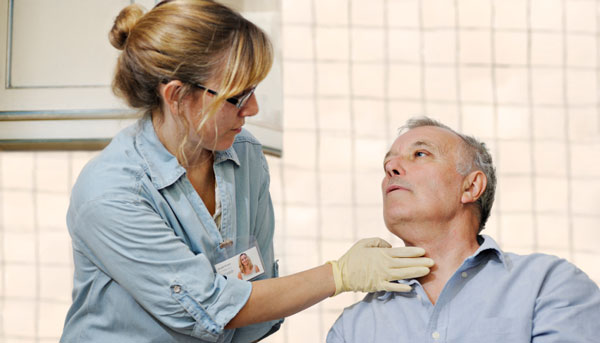Swallowing Reflex and Muscles: Considerations As We Age
Many people do not realize that the act of swallowing is actually a complex reflex. As we chew our food, it forms a nice moist ball in our mouth, called a bolus, which is eventually propelled to the back of our throat with our tongue. When a bolus reaches a certain point in the back of our throats, our bodies recognize that we need to swallow.
Think of it as similar to the doctor hitting your knee with a small hammer, and your leg jerking in response: the bolus hitting the back of the throat is like the hammer, and your muscles moving to close off your airway and open up your swallowing tube, esophagus, to your stomach is like the leg jerking. It is a magnificent mechanism to transport your food to your stomach, and protect your lungs from food and drink entering them.
It is important to keep in mind that as we age our reflexes begin to slow down, and this includes the swallowing reflex. In addition to our reflexes slowing down, our muscles also may not be as strong as they once were when we were younger – this goes not only for your arms, legs, and abs, but also for your swallowing muscles.
These changes can at times cause problems with the safety of our swallow. When problems do arise, they can lead to illness, the most significant being pneumonia. For example, if your swallow reflex is not as fast as it once was, it may not trigger your muscles to close off your airway in time to protect it from that tasty bite of a meal or sip of a delicious beverage from penetrating into your airway.
You may tear up, start to cough, feel the need to clear your throat, or sound as if you have a ‘frog stuck in your throat’ when you start to speak. For another example, if your swallowing muscles are not as strong as they once were and they can’t squeeze and propel the food down strong and fast enough through your esophagus to your stomach, you may have left over pieces of food hanging around the back of your throat when your airway re-opens. The food that remains can be sucked into your airway as you breathe. It is when food or drink slips into the airway and down into our lungs, along with some bacteria from our mouths, that a case of pneumonia can develop.
Many people never develop swallowing difficulties or pneumonia, but it is good to be aware of some red flags that indicate you or your loved one’s swallow should be looked at. Here are some of those red flags:
- During or shortly after you eat or drink you feel as though it is getting stuck in your throat.
- You cough, or clear your throat when you eat or drink, or shortly thereafter.
- You notice that your voice changes in quality during or just after eating or drinking.
- Your eyes tear up when you are eating or drinking.
- You feel like you have to swallow many times in order to get things down ‘properly’.
- You feel as though you choke on your food more than the average person does.
- You have a hard time clearing your mouth of all of the food you have been chewing.
- You find that food collects in different parts of your mouth, and you need to physically clear it with a sip of a drink, by really working at it with your tongue, or by using your finger.
This list is not exhaustive, but should give you a good idea of what to look for if you feel your swallow isn’t as efficient as it once was. If you have noticed any of these things, or are concerned about something that is not on this list, speak to your doctor about having a swallowing assessment done with a speech-language pathologist (SLP). By having your swallow examined, you can partner with your SLP to do some exercises, and/or use some strategies to help improve your swallowing safety.
If your swallowing profile is more complex, the SLP may recommend that you have a modified barium swallow study (MBS) completed. This means the SLP recommends you have an x-ray done of your swallowing in order to better understand what is going on as you swallow. It gives a more definite picture of what is going on as you swallow with the timing of the reflex and how the muscles are moving. From this study the SLP may give you additional
recommendations or strategies to improve the safety of your swallow.
The great news is, depending on the reason for your swallowing issues, that swallowing strategies and exercises can improve the safety and/or the strength of your swallow.
* * * * *
 Megan Wood Pagonis, M.Sc. SLP(C), reg. CASLPO Speech-Language Pathologist
Megan Wood Pagonis, M.Sc. SLP(C), reg. CASLPO Speech-Language Pathologist


